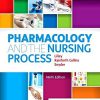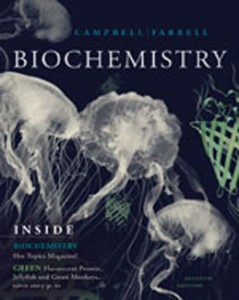Test Bank for Biochemistry, 7th Edition: Campbell
$35.00 Original price was: $35.00.$26.50Current price is: $26.50.
Test Bank for Biochemistry, 7th Edition: Campbell
Test Bank for Biochemistry, 7th Edition: Campbell
Product details:
- ISBN-10 : 0840068581
- ISBN-13 : 978-0840068583
- Author: Mary K. Campbell, Shawn O. Farrell
Discover how the latest developments in biotechnology and genomics directly affect your life with this best-selling biochemistry text. This new edition reflects recent developments in stem cell research, cloning, and immunology, and offers revised coverage of major topics, such as Molecular Biology. Known for its logical organization and appropriate depth of coverage, BIOCHEMISTRY, 7th Edition, balances scientific detail with readability that’s ideal for those studying biochemistry for the first time. A unique magazine insert, “Hot Topics in Biochemistry,” introduces the latest advances in the field. State-of-the art visuals throughout the book help clarify concepts, while “Biochemical Connections” demonstrate how biochemistry affects other fields, such as health and sports medicine New in-text questions help you master key concepts of biochemistry, while end-of-chapter problem sets grouped by problem types help you master problem-solving skills.
Table of contents:
New to This Edition……Page 23
Organization……Page 25
Student and Instructor Resources……Page 27
Student Resources……Page 28
Reviewers Acknowledgments……Page 29
A Final Note from Shawn Farrell……Page 30
Magazine: Hot Topics in Biochemistry……Page 745
Green Fluorescent Protein: Jellyfish and Green Monkeys……Page 747
DNA and Family Trees: Who Is a Relative?……Page 750
Diabetes: An Epidemic for Modern Times……Page 754
Just One Word: Nanotechnology……Page 757
Small, Smaller, Smallest: Beyond the Electron Microscope to Single Molecules……Page 761
HPV Vaccines: Waging the War on Cervical Cancer……Page 764
Stem Cells: Hope or Hype?……Page 767
Doping in Sports: Good Science Gone Bad……Page 772
1.1: Basic Themes……Page 31
1.2: Chemical Foundations of Biochemistry……Page 33
The Earth and Its Age……Page 34
Biomolecules……Page 36
Molecules to Cells……Page 40
1.4: The Biggest Biological Distinction—Prokaryotes and Eukaryotes……Page 43
1.6: Eukaryotic Cells……Page 46
1.7: Five Kingdoms, Three Domains……Page 51
Biochemical Connections: Extremophiles: The Toast of the Industry……Page 53
1.8: Common Ground for All Cells……Page 54
1.9: Biochemical Energetics……Page 56
1.10: Energy and Change……Page 57
1.12: Life and Thermodynamics……Page 58
Biochemical Connections: Predicting Reactions……Page 59
Summary……Page 60
Review Exercises……Page 61
Annotated Bibliography……Page 63
2.1: Water and Polarity……Page 65
Solvent Properties of Water……Page 66
2.2: Hydrogen Bonds……Page 69
Other Biologically Important Hydrogen Bonds……Page 72
Biochemical Connections: How Basic Chemistry Affects Life: The Importance of the Hydrogen Bond……Page 73
2.3: Acids, Bases, and pH……Page 74
2.4: Titration Curves……Page 77
2.5: Buffers……Page 79
Biochemical Connections: Buffer Selection……Page 85
Biochemical Connections: Some Physiological Consequences of Blood Buffering……Page 86
Summary……Page 87
Review Exercises……Page 88
Annotated Bibliography……Page 90
3.1: Amino Acids Exist in a Three-Dimensional World……Page 91
3.2: Individual Amino Acids: Their Structures and Properties……Page 92
Uncommon Amino Acids……Page 96
3.3: Amino Acids Can Act as Both Acids and Bases……Page 97
Biochemical Connections: Amino Acids to Calm Down and Pep Up……Page 98
3.4: The Peptide Bond……Page 102
3.5: Small Peptides with Physiological Activity……Page 104
Biochemical Connections: Amino Acids Go Many Different Places……Page 105
Biochemical Connections: Peptide Hormones—Small Molecules with Big Effects……Page 107
Biochemical Connections: Phenylketonuria—Little Molecules Have Big Effects……Page 108
Summary……Page 109
Review Exercises……Page 110
Annotated Bibliography……Page 111
4.1: Protein Structure and Function……Page 113
4.3: Secondary Structure of Proteins……Page 114
Periodic Structures in Protein Ba……Page 115
Irregularities in Regular Structures……Page 117
Supersecondary Structures and Domains……Page 118
The Collagen Triple Helix……Page 120
4.4: Tertiary Structure of Proteins……Page 123
Forces Involved in Tertiary Structures……Page 124
Myoglobin: An Example of Protein Structure……Page 126
Denaturation and Refolding……Page 129
Hemoglobin……Page 130
Conformational Changes That Accompany Hemoglobin Function……Page 132
4.6: Protein Folding Dynamics……Page 136
Hydrophobic Interactions: A Case Study in Thermodynamics……Page 137
The Importance of Correct Folding……Page 139
Protein-Folding Chaperones……Page 140
Biochemical Connections: Protein Folding Diseases……Page 141
Summary……Page 143
Review Exercises……Page 144
Annotated Bibliography……Page 145
5.1: Extracting Pure Proteins from Cells……Page 147
5.2: Column Chromatography……Page 148
5.3: Electrophoresis……Page 156
5.4: Determining the Primary Structure of a Protein……Page 157
Sequencing of Peptides: The Edman Method……Page 159
Biochemical Connections: The Power of Mass Spectrometry……Page 164
Summary……Page 165
Review Exercises……Page 166
Annotated Bibliography……Page 168
6.2: Kinetics versus Thermodynamics……Page 169
6.3: Enzyme Kinetic Equations……Page 172
6.4: Enzyme–Substrate Binding……Page 174
6.5: Examples of Enzyme-Catalyzed Reactions……Page 176
Biochemical Connections: Enzymes and Memory……Page 177
6.6: The Michaelis–Menten Approach to Enzyme Kinetics……Page 178
Biochemical Connections: Enzyme Lets You Enjoy Champagne……Page 184
6.7: Enzyme Inhibition……Page 185
Biochemical Connections: Practical Information from Kinetic Data……Page 187
Summary……Page 190
Review Exercises……Page 191
Annotated Bibliography……Page 193
7.1: The Behavior of Allosteric Enzymes……Page 195
7.2: The Concerted and Sequential Models for Allosteric Enzymes……Page 199
7.3: Control of Enzyme Activity by Phosphorylation……Page 203
7.4: Zymogens……Page 205
7.5: The Nature of the Active Site……Page 207
7.6: Chemical Reactions Involved in Enzyme Mechanisms……Page 212
7.7: The Active Site and Transition States……Page 214
Biochemical Connections: Families of Enzymes: Proteases……Page 215
7.8: Coenzymes……Page 217
Biochemical Connections: Catalytic Antibodies against Cocaine……Page 219
Summary……Page 220
Review Exercises……Page 221
Annotated Bibliography……Page 222
8.2: The Chemical Natures of the Lipid Types……Page 223
8.3: Biological Membranes……Page 230
Biochemical Connections: Butter versus Margarine—Which Is Healthier?……Page 234
8.4: The Kinds of Membrane Proteins……Page 235
8.5: The Fluid-Mosaic Model of Membrane Structure……Page 237
Biochemical Connections: Membranes in Drug Delivery……Page 238
8.6: The Functions of Membranes……Page 239
Biochemical Connections: Lipid Droplets Are Not Just Great Balls of Fat……Page 243
Vitamin D……Page 244
Biochemical Connections: Vision Has Great Chemistry……Page 247
Vitamin K……Page 248
8.8: Prostaglandins and Leukotrienes……Page 249
Summary……Page 252
Review Exercises……Page 253
Annotated Bibliography……Page 255
9.2: The Covalent Structure of Polynucleotides……Page 257
9.3: The Structure of DNA……Page 262
Biochemical Connections: Who Owns Your Genes?……Page 269
Biochemical Connections: The Human Genome Project: Treasure or Pandora’s Box?……Page 270
9.4: Denaturation of DNA……Page 271
9.5: The Principal Kinds of RNA and Their Structures……Page 272
Biochemical Connections: Why Identical Twins Are Not Identical……Page 278
Summary……Page 279
Review Exercises……Page 280
Annotated Bibliography……Page 281
10.1: The Flow of Genetic Information in the Cell……Page 283
Semiconservative Replication……Page 284
Semidiscontinuous DNA Replication……Page 286
DNA Polymerase from E. coli……Page 288
Supercoiling and Replication……Page 291
The Primase Reaction……Page 292
10.5: Proofreading and Repair……Page 293
Biochemical Connections: Why Does DNA Contain Thymine and Not Uracil?……Page 297
10.6: DNA Recombination……Page 298
10.7: Eukaryotic DNA Replication……Page 300
Biochemical Connections: The SOS Response in E. coli……Page 301
Eukaryotic DNA Polymerases……Page 303
The Eukaryotic Replication Fork……Page 304
Summary……Page 307
Review Exercises……Page 308
Annotated Bibliography……Page 309
11.1: Overview of Transcription……Page 311
RNA Polymerase in Escherichia coli……Page 312
Promoter Structure……Page 313
Chain Elongation……Page 314
Alternative s Factors……Page 317
Operons……Page 319
Transcription Attenuation……Page 324
Biochemical Connections: Riboswitches Provide Another Weapon Against Pathogens……Page 325
11.4: Transcription in Eukaryotes……Page 326
Structure of RNA Polymerase II……Page 327
Pol II Promoters……Page 328
Initiation of Transcription……Page 329
Elongation and Termination……Page 331
Enhancers and Silencers……Page 332
Biochemical Connections: TFIIH—Making the Most Out of the Genome……Page 333
Response Elements……Page 334
11.6: Non-Coding RNAs……Page 337
Biochemical Connections: A MicroRNA Helps Regenerate Nerve Synapses After Injury……Page 338
Helix–Turn–Helix Motifs……Page 339
Transcription-Activation Domains……Page 341
11.8: Posttranscriptional RNA Modification……Page 342
Transfer RNA and Ribosomal RNA……Page 343
Messenger RNA……Page 344
The Splicing Reaction: Lariats and Snurps……Page 345
Alternative RNA Splicing……Page 346
11.9: Ribozymes……Page 347
Summary……Page 349
Review Exercises……Page 351
Annotated Bibliography……Page 352
12.1: Translating the Genetic Message……Page 353
12.2: The Genetic Code……Page 354
Codon–Anticodon Pairing and Wobble……Page 356
12.3: Amino Acid Activation……Page 359
Chain Initiation……Page 361
Chain Elongation……Page 364
The Ribosome Is a Ribozyme……Page 366
Biochemical Connections: The 21st Amino Acid 339 Polysomes……Page 369
Polysomes……Page 370
12.5: Eukaryotic Translation……Page 371
Chain Initiation……Page 372
Chain Elongation……Page 373
Biochemical Connections: Protein Synthesis Makes Memories……Page 374
12.6: Posttranslational Modification of Proteins……Page 375
Biochemical Connections: Chaperones: Preventing Unsuitable Associations……Page 376
12.7: Protein Degradation……Page 377
Biochemical Connections: Silent Mutations Are Not Always Silent……Page 378
Biochemical Connections: How Do We Adapt to High Altitude?……Page 381
Review Exercises……Page 382
Annotated Bibliography……Page 384
Separation Techniques……Page 385
Detection Methods……Page 386
13.2: Restriction Endonucleases……Page 387
Many Restriction Endonucleases Produce“ Sticky Ends”……Page 388
Using “Sticky Ends” to Construct Recombinant DNA……Page 390
13.4: Genetic Engineering……Page 397
Bacteria as “Protein Factories”……Page 398
Biochemical Connections: Genetic Engineering in Agriculture……Page 399
Protein Expression Vectors……Page 400
Genetic Engineering in Eukaryotes……Page 402
Biochemical Connections: Human Proteins through Genetic Recombination Techniques……Page 403
13.5: DNA Libraries……Page 404
Biochemical Connections: Fusion Proteins and Fast Purifications……Page 405
Finding an Individual Clone in a DNA Library……Page 406
13.6: The Polymerase Chain Reaction……Page 407
Biochemical Connections: CSI: Biochemistry—Forensic Uses of DNA Testing……Page 409
13.7: DNA Fingerprinting……Page 411
Restriction-Fragment Length Polymorphisms:A Powerful Method for Forensic Analysis……Page 412
13.8: Sequencing DNA……Page 414
Biochemical Connections: RNA Interference—The Newest Way to Study Genes……Page 415
13.9: Genomics and Proteomics……Page 417
The Power of Microarrays—Robotic Technology Meets Biochemistry……Page 418
Protein Arrays……Page 420
Summary……Page 421
Review Exercises……Page 422
Annotated Bibliography……Page 423
Families of Viruses……Page 425
Virus Life Cycles……Page 426
Biochemical Connections: A Little Swine Goes a Long Way……Page 430
14.2: Retroviruses……Page 431
Biochemical Connections: Viruses Are Used for Gene Therapy……Page 433
14.3: The Immune System……Page 434
Innate Immunity—The Front Lines of Defense……Page 435
T-Cell Functions……Page 436
The Immune System: Molecular Aspects……Page 441
Biochemical Connections: Modern Science Takes on the Flu Virus……Page 443
Distinguishing Self from Nonself……Page 444
Biochemical Connections: Viral RNAs Outwit the Immune System……Page 445
14.4: Cancer……Page 446
Biochemical Connections: Cancer: The Dark Side of the Human Genome……Page 447
Oncogenes……Page 448
Tumor Suppressors……Page 449
Viruses Helping Cure Cancer……Page 451
Biochemical Connections: Nanotech Tackles Cancer……Page 452
Biochemical Connections: Attacking the Symptoms instead of the Disease?……Page 454
Summary……Page 455
Review Exercises……Page 456
Annotated Bibliography……Page 457
15.1: Standard States for Free-Energy Changes……Page 459
15.2: A Modified Standard State for Biochemical Applications……Page 460
Biochemical Connections: Living Things Need Energy—How Do They Use It?……Page 461
15.4: The Role of Oxidation and Reduction in Metabolism……Page 462
Biochemical Connections: Living Things Are Unique Thermodynamic Systems……Page 463
15.5: Coenzymes in Biologically Important Oxidation–Reduction Reactions……Page 464
15.6: Coupling of Production and Use of Energy……Page 468
Biochemical Connections: ATP in Cell Signaling……Page 471
15.7: Coenzyme A in Activation of Metabolic Pathways……Page 473
Summary……Page 476
Review Exercises……Page 477
Annotated Bibliography……Page 479
16.1: Sugars: Their Structures and Stereochemistry……Page 481
Biochemical Connections: Low-Carbohydrate Diets……Page 487
16.2: Reactions of Monosaccharides……Page 489
Biochemical Connections: Vitamin C Is Related to Sugars……Page 491
16.3: Some Important Oligosaccharides……Page 494
Biochemical Connections: Fruits, Flowers, Striking Colors, and Medicinal Uses Too……Page 496
Biochemical Connections: Lactose Intolerance: Why Do So Many People Not Want to Drink Milk?……Page 497
16.4: Structures and Functions of Polysaccharides……Page 498
Biochemical Connections: Why Is Dietary Fiber So Good for You?……Page 504
16.5: Glycoproteins……Page 505
Biochemical Connections: Glycoproteins and Blood Transfusions……Page 506
Review Exercises……Page 507
Annotated Bibliography……Page 509
17.1: The Overall Pathway of Glycolysis……Page 511
Biochemical Connections: Biofuels from Fermentation……Page 514
17.2: Conversion of Six-Carbon Glucose to Three-Carbon Glyceraldehyde-3-Phosphate……Page 515
Biochemical Connections: Dolphins as a Model for Humans with Diabetes……Page 518
17.3: Glyceraldehyde-3-Phosphate Is Converted to Pyruvate……Page 521
17.4: Anaerobic Metabolism of Pyruvate……Page 529
Biochemical Connections: What Is the Connection between Anaerobic Metabolism and Dental Plaque?……Page 532
17.5: Energy Production in Glycolysis……Page 533
Summary……Page 534
Review Exercises……Page 535
Annotated Bibliography……Page 536
18.1: How Glycogen Is Produced and Degraded……Page 537
18.2: Gluconeogenesis Produces Glucose from Pyruvate……Page 544
18.3: Control of Carbohydrate Metabolism……Page 549
Biochemical Connections: Using Pyruvate Kinase Isozymes to Treat Cancer……Page 553
18.4: Glucose Is Sometimes Diverted through the Pentose Phosphate Pathway……Page 554
Biochemical Connections: The Pentose Phosphate Pathway and Hemolytic Anemia……Page 558
Summary……Page 559
Review Exercises……Page 560
Annotated Bibliography……Page 561
19.2: The Overall Pathway of the Citric Acid Cycle……Page 563
19.3: How Pyruvate Is Converted to Acetyl-CoA……Page 565
19.4: The Individual Reactions of the Citric Acid Cycle……Page 570
Biochemical Connections: Fluorine Compounds and Carbohydrate Metabolism……Page 573
19.5: Energetics and Control of the Citric Acid Cycle……Page 577
19.6: The Glyoxylate Cycle: A Related Pathway……Page 580
19.7: The Citric Acid Cycle in Catabolism……Page 581
19.8: The Citric Acid Cycle in Anabolism……Page 582
Biochemical Connections: Why Can’t Animals Use All the Same Energy Sources as Plants and Bacteria?……Page 586
19.9: The Link to Oxygen……Page 587
Biochemical Connections: Why Is It So Hard to Lose Weight?……Page 588
Summary……Page 589
Review Exercises……Page 590
Annotated Bibliography……Page 591
20.1: The Role of Electron Transport in Metabolism……Page 593
20.2: Reduction Potentials in the Electron Transport Chain……Page 594
20.3: Organization of Electron Transport Complexes……Page 596
Biochemical Connections: Mito What . . . ? The Consequences of Mitochondrial Disease……Page 602
20.4: The Connection between Electron Transport and Phosphorylation……Page 604
20.5: The Mechanism of Coupling in Oxidative Phosphorylation……Page 607
20.6: Respiratory Inhibitors Can Be Used to Study Electron Transport……Page 610
20.7: Shuttle Mechanisms……Page 613
Biochemical Connections: Sports and Metabolism……Page 615
Summary……Page 616
Review Exercises……Page 618
Annotated Bibliography……Page 619
21.2: Catabolism of Lipids……Page 621
21.3: The Energy Yield from the Oxidation of Fatty Acids……Page 626
21.4: Catabolism of Unsaturated Fatty Acids and Odd-Carbon Fatty Acids……Page 628
21.5: Ketone Bodies……Page 631
Biochemical Connections: Transcription Activators in Lipid Biosynthesis……Page 632
Biochemical Connections: A Gene for Obesity……Page 639
Biochemical Connections: Acetyl-CoA Carboxylase—A New Target in the Fight against Obesity?……Page 642
21.8: Cholesterol Biosynthesis……Page 643
Biochemical Connections: Atherosclerosis……Page 652
Summary……Page 653
Review Exercises……Page 654
Annotated Bibliography……Page 655
22.1: Chloroplasts Are the Site of Photosynthesis……Page 657
Biochemical Connections: The Relationship between Wavelength and Energy of Light……Page 660
22.2: Photosystems I and II and the Light Reactions of Photosynthesis……Page 661
Cyclic Electron Transport in Photosystem……Page 665
22.3: Photosynthesis and ATP Production……Page 667
Biochemical Connections: Improving the Yield of Anti-Malarial Plants……Page 668
22.4: Evolutionary Implications of Photosynthesis with and without Oxygen……Page 669
Biochemical Connections: Plants Feed Animals—Plants Need Energy—Plants Can Produce Energy……Page 670
22.5: Dark Reactions of Photosynthesis Fix CO(2)……Page 672
Biochemical Connections: Chloroplast Genes……Page 676
Summary……Page 679
Review Exercises……Page 680
Annotated Bibliography……Page 681
23.2: Nitrogen Fixation……Page 683
Biochemical Connections: Why Is the Nitrogen Content of Fertilizers So Important?……Page 685
23.4: Amino Acid Biosynthesis……Page 686
23.6: Amino Acid Catabolism……Page 696
Excretion of Excess Nitrogen……Page 697
Biochemical Connections: Water and the Disposal of Nitrogen Wastes……Page 698
Biochemical Connections: Chemotherapy and Antibiotics—Taking Advantage of the Need for Folic Acid……Page 701
Anabolism of Inosine Monophosphate……Page 702
23.8: Purine Catabolism……Page 704
Biochemical Connections: Cytoplasmic Defenses against Gout……Page 707
Pyrimidine Catabolism……Page 708
23.10: Conversion of Ribonucleotides to Deoxyribonucleotides……Page 711
23.11: Conversion of dUDP to dTTP……Page 712
Review Exercises……Page 713
Annotated Bibliography……Page 715
24.2: Biochemistry and Nutrition……Page 717
Biochemical Connections: Alcohol Consumption and Addiction……Page 719
The Food Pyramid……Page 722
Hormones……Page 725
Cyclic AMP and G Proteins……Page 729
Calcium Ion as a Second Messenger……Page 730
Receptor Tyrosine Kinases……Page 731
24.4: Hormones and the Control of Metabolism……Page 733
24.5: Insulin and Its Effects……Page 736
Insulin’s Effect on Glucose Uptake……Page 737
Diabetes……Page 738
Biochemical Connections: A Workout a Day Keeps Diabetes Away?……Page 739
Biochemical Connections: Aging and the Search for Longevity……Page 740
Review Exercises……Page 742
Annotated Bibliography……Page 744
Glossary……Page 777
1.2: Chemical Foundations of Biochemistry……Page 791
1.8: Common Ground for All Cells……Page 792
2.3: Acids, Bases, and pH……Page 793
2.4: Titration Curves……Page 794
3.1: Amino Acids Exist in a Three-Dimensional World……Page 796
4.2: Primary Structure of Proteins……Page 798
4.5: Quaternary Structure of Proteins……Page 799
5.2: Column Chromatography……Page 801
5.3: Electrophoresis……Page 802
6.2: Kinetics versus Thermodynamics……Page 803
7.3: Control of Enzyme Activity by Phosphorylation……Page 806
7.7: The Active Site and Transition States……Page 807
8.2: The Chemical Natures of the Lipid Ty……Page 808
8.4: The Kinds of Membrane Proteins……Page 809
9.3: The Structure of DNA……Page 810
9.4: Denaturation of DNA……Page 811
10.4: Proteins Required for DNA Replication……Page 812
10.7: Eukaryotic DNA Replication……Page 813
11.3: Transcription Regulation in Prokaryotes……Page 814
11.5: Transcription Regulation in Eukaryotes……Page 815
12.2: The Genetic Code……Page 816
12.4: Prokaryotic Translation……Page 817
12.6: Posttranslational Modification of Proteins……Page 818
13.3: Cloning……Page 819
13.8: Sequencing DNA……Page 820
14.1: Viruses……Page 821
14.4: Cancer……Page 822
15.2: A Modified Standard State for Biochemical Applications……Page 823
15.5: Coenzymes in Biologically Important Oxidation–Reduction Reactions……Page 824
16.1 Sugars: Their Structures and Stereochemistry……Page 825
17.2: Conversion of Six-Carbon Glucose to Three-Carbon Glyceraldehyde-3-Phosphate……Page 828
17.4: Anaerobic Metabolism of Pyruvate……Page 829
18.3: Control of Carbohydrate Metabolism……Page 831
18.4: Glucose Is Sometimes Diverted through the Pentose Phosphate Pathway……Page 832
19.4: The Individual Reactions of the Citric Acid Cycle……Page 833
19.5: Energetics and Control of the Citric Acid Cycle……Page 834
20.2: Reduction Potentials in the Electron Transport Chain……Page 835
20.3: Organization of Electron Transport Complexes……Page 836
21.1: Lipids Are Involved in the Generation and Storage of Energy……Page 837
21.6: Fatty-Acid Biosynthesis……Page 838
22.2: Photosystems I and II and the Light Reactions of Photosyn thesis……Page 839
22.5: Dark Reactions of Photosynthesis Fix CO2……Page 840
23.4: Amino Acid Biosynthesis……Page 841
23.6: Amino Acid Catabolism……Page 842
24.1: Connections between Metabolic Pathways……Page 843
24.2: Biochemistry and Nutrition……Page 844
24.5: Insulin and Its Eff
People also search:
Biochemistry
Biochemistry Campbell
Biochemistry Campbell 7th
Biochemistry Campbell 7th Test Bank
Test Bank for Biochemistry, 7th Edition: Campbell Download
Related products
Test Bank
Test Bank for Decision Support and Business Intelligence Systems, 9th Edition: Efraim Turban












